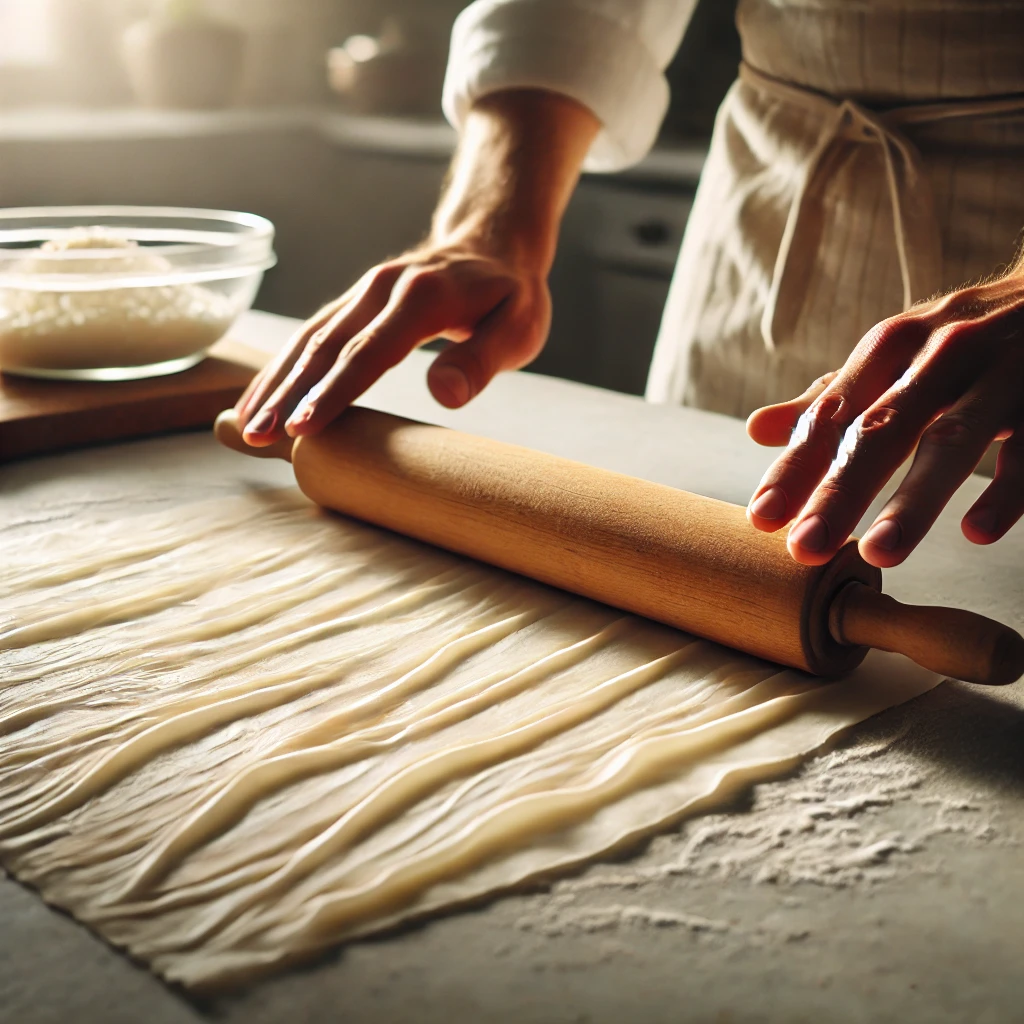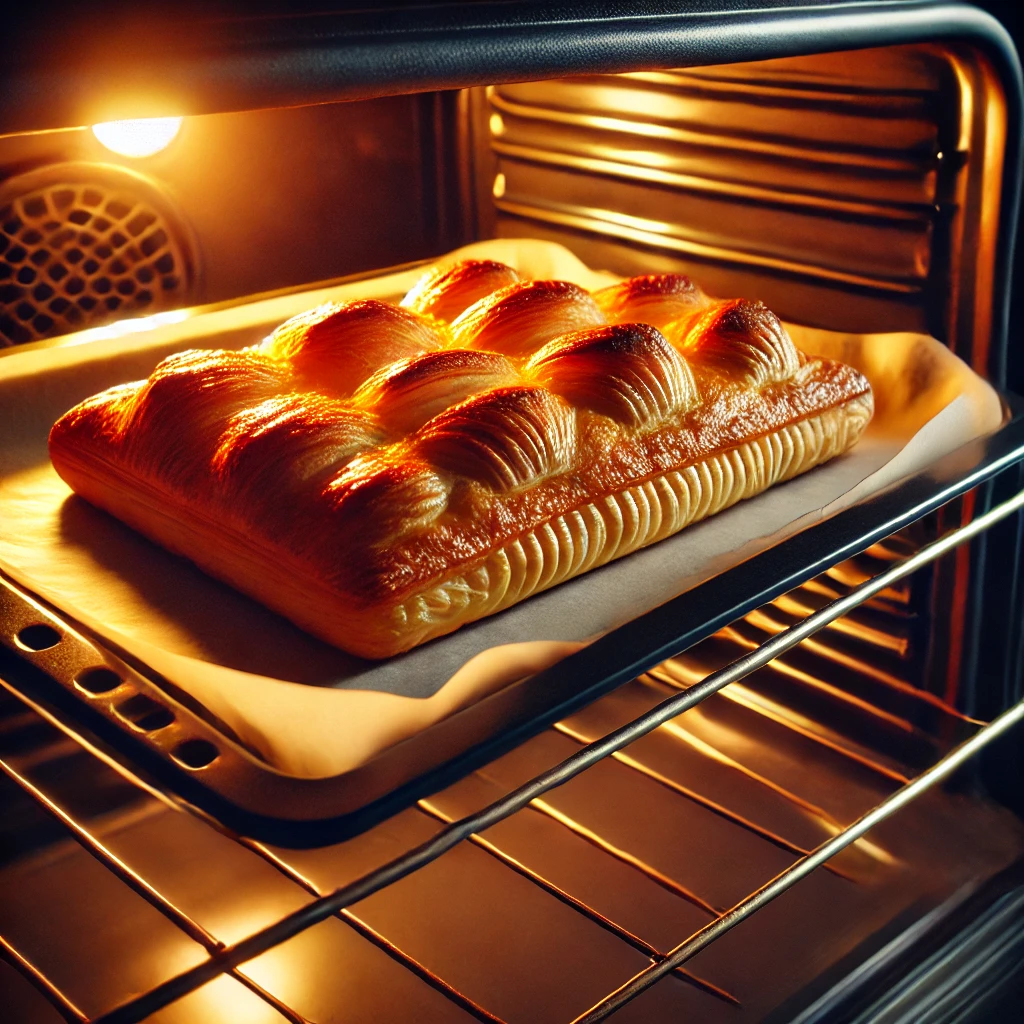Table of contents
Introduction
When it comes to baking, especially in dessert recipes, two of the most popular types of dough are phyllo dough and puff pastry. Although both can create flaky, crispy, and delicious pastries, many people often wonder: Is phyllo dough the same as puff pastry?
The answer is no. While both doughs are used to create flaky, light layers in baked goods, there are significant differences between the two in terms of texture, composition, and how they are used in recipes. Understanding these differences is crucial when choosing the right dough for your puff pastry dessert recipes or savory dishes.
In this article, we’ll explore the key differences between phyllo dough and puff pastry, how they are made, and when to use each in your kitchen.
1. What is Phyllo Dough?
Phyllo dough, also known as filo dough, is a type of pastry that is known for its delicate, paper-thin layers. This dough is commonly used in Middle Eastern, Mediterranean, and Eastern European cuisine. Phyllo dough is made from flour, water, and a small amount of oil or vinegar. The dough is stretched into extremely thin sheets and layered to form the base of dishes like baklava, spanakopita, and other savory pastries.
When baked, phyllo dough becomes crisp and flaky. Unlike puff pastry, phyllo does not puff up as much because it is not made with the same layers of fat. Instead, the layers remain crispy and flaky, which is perfect for certain desserts and savory pies.
2. What is Puff Pastry?

Puff pastry is a richer, more complex dough made from layers of dough and fat (usually butter). This dough is rolled out, folded, and chilled multiple times to create the characteristic flaky layers. The butter in puff pastry releases steam when baked, causing the layers to puff up and separate, resulting in a light and airy texture.
Puff pastry is often used in both sweet and savory dishes, from croissants and fruit tarts to quiches and vol-au-vents. Its versatility and ability to create a light, flaky texture make it a favorite for puff pastry dessert recipes, such as apple turnovers, cream horns, and chocolate-filled pastries.
3. Key Differences Between Phyllo Dough and Puff Pastry
While both doughs are used for flaky, crispy pastries, here are the primary differences:
| Feature | Phyllo Dough | Puff Pastry |
|---|---|---|
| Layers | Paper-thin, delicate layers. | Multiple thick layers formed with butter. |
| Texture | Crisp and crunchy, not puffy. | Light, airy, and puffed up due to steam. |
| Fat Content | Minimal fat (usually just oil or butter). | High fat content (butter) for the puffing effect. |
| Use | Ideal for thin, crispy pastries (e.g., baklava). | Best for airy, flaky pastries (e.g., croissants). |
| Baking | Needs to be brushed with butter or oil between layers. | Puffs up when baked due to steam from butter. |
4. Which One to Use for Desserts?

When choosing between phyllo dough and puff pastry for your dessert recipes, the decision depends on the kind of texture and result you want to achieve.
- Phyllo Dough: Choose phyllo for desserts that require a crisp, layered texture, such as baklava or phyllo fruit strudels. It’s great for creating thin, crunchy layers, but it won’t puff up. If you want a lighter dessert, phyllo might be your best bet.
- Puff Pastry: Opt for puff pastry when you want a rich, buttery, and light texture that puffs up beautifully when baked. Puff pastry dessert recipes, like apple turnovers, cream-filled pastries, or palmiers, require puff pastry because of its ability to expand and form airy layers.
5. Substituting One for the Other
While phyllo dough and puff pastry are not the same, it’s possible to substitute one for the other in some recipes. However, the results may vary depending on the dish:
- Substituting Phyllo for Puff Pastry: If you’re making a dish that calls for puff pastry but only have phyllo dough, keep in mind that you’ll lose the puffed texture. Phyllo can give a crispy, light result but will not rise like puff pastry. If this is acceptable for your recipe, go ahead and use phyllo, but adjust your expectations for the texture.
- Substituting Puff Pastry for Phyllo: Using puff pastry in a recipe that calls for phyllo dough will result in a much richer and puffier texture. For example, a dessert like baklava made with puff pastry will have a different texture and taste, being more buttery and less crisp than traditional baklava made with phyllo.
6. Frequently Asked Questions (FAQs)
1. Can I freeze phyllo dough?
Yes, phyllo dough can be frozen. It should be wrapped tightly in plastic wrap and placed in a freezer-safe bag. Thaw it in the fridge before use.
2. Can I make puff pastry at home?
Yes, puff pastry can be made from scratch, but it requires time and patience. It involves folding dough and butter repeatedly to create thin layers. Store-bought puff pastry is a convenient alternative.
3. What’s the best way to store leftover puff pastry?
Leftover puff pastry can be wrapped tightly in plastic wrap and refrigerated for up to 2-3 days. If you want to keep it longer, you can freeze it.
4. Can I use puff pastry for savory dishes?
Yes, puff pastry is versatile and can be used for both sweet and savory dishes. Examples include cheese turnovers, mini quiches, and savory pies.
5. How do I keep phyllo dough from drying out?
To prevent phyllo dough from drying out, cover the sheets with a damp cloth while working with them. Only remove one sheet at a time to keep the rest moist.
6. Can I use phyllo dough for puff pastry recipes?
While phyllo dough can be used in some recipes that call for puff pastry, the result will be different. Phyllo dough will not puff up like puff pastry because it doesn’t contain the layers of butter that cause puff pastry to rise. However, phyllo dough can still create a crispy, layered texture if you’re looking for a different but tasty result.
7. Is phyllo dough healthier than puff pastry?
Phyllo dough is generally considered a lighter option compared to puff pastry. It contains fewer calories and fat because it uses less butter or oil in its layers. Puff pastry, on the other hand, is richer due to the high butter content, making it more calorie-dense and indulgent.
8. How long does puff pastry take to bake?
Puff pastry typically bakes at a high temperature, around 400°F (200°C), for 15-20 minutes. The exact time depends on the recipe and the size of the pastry. Puff pastry should be golden brown and puffed up when done.
9. Can I make phyllo dough from scratch?
Yes, phyllo dough can be made from scratch, but it requires skill and patience. The dough is traditionally rolled out very thin, and this process can be time-consuming. If you don’t have the time or experience, pre-made phyllo dough is widely available in stores.
10. How do I keep puff pastry from becoming soggy?
To prevent puff pastry from becoming soggy, make sure your filling is not too wet, and bake the pastry on a parchment-lined baking sheet. You can also pre-bake the pastry shell (also known as “blind baking”) before adding the filling to keep it crisp.
11. Can I use phyllo dough in sweet recipes?
Yes, phyllo dough can be used in both savory and sweet recipes. In fact, it is often used in sweet dishes like baklava, fruit strudels, or layered custard tarts. The crispy texture pairs wonderfully with sweet ingredients like honey, nuts, and chocolate.
12. What’s the best way to shape puff pastry?
Shaping puff pastry is easy once it’s rolled out. You can cut it into squares, triangles, or even circles, depending on the recipe. For elegant shapes, such as vol-au-vents or pinwheels, simply roll the pastry into the desired shape before baking.
13. How do I thaw frozen puff pastry?
To thaw frozen puff pastry, leave it in the fridge overnight. If you’re short on time, you can thaw it at room temperature for about 30 minutes. Be sure to unwrap the pastry from its packaging and allow it to thaw on a flat surface.
14. Can puff pastry be made ahead of time?
Yes, you can prepare puff pastry ahead of time. After rolling it out, you can freeze the dough for up to a month. Simply wrap it tightly in plastic wrap and place it in an airtight bag or container. Thaw before using, and it will work just as fresh.
15. Can I use butter alternatives in puff pastry?
While traditional puff pastry recipes rely on butter for its rich flavor and flaky texture, you can experiment with butter alternatives like margarine or vegetable shortening. Keep in mind that this may alter the texture and flavor of your pastry slightly, but it’s a viable option for those looking for dairy-free or vegan alternatives.
Conclusion
In summary, while phyllo dough and puff pastry may appear similar at first glance, they differ significantly in texture, fat content, and how they are used in dessert recipes. Phyllo dough is ideal for light, crispy pastries, while puff pastry is perfect for achieving a rich, flaky, and airy texture. Both doughs have their place in the kitchen, and understanding when and how to use them will help you create the perfect pastry for your next dish.
Whether you’re making baklava with phyllo or apple turnovers with puff pastry, each dough has unique qualities that make it special. Now that you know the differences between them, you can confidently choose the right one for your baking needs.

